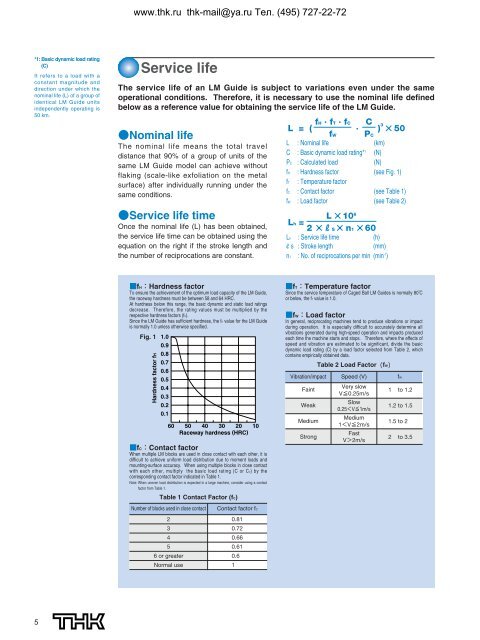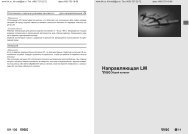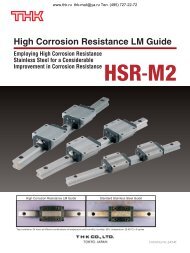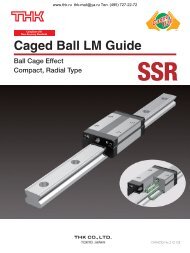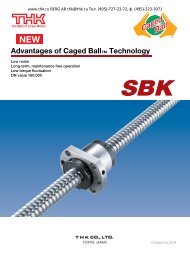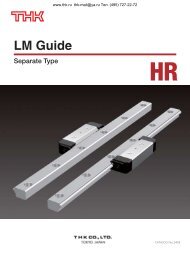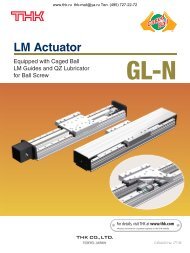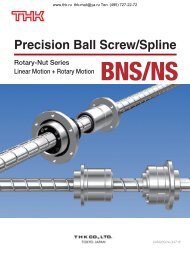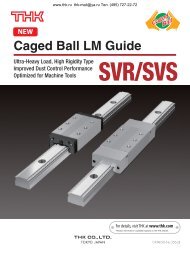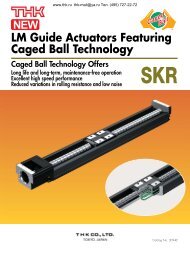Create successful ePaper yourself
Turn your PDF publications into a flip-book with our unique Google optimized e-Paper software.
www.thk.ru thk-mail@ya.ru Тел. (495) 727-22-72*1: Basic dynamic load rating(C)It refers to a load with aconstant magnitude anddirection under which thenominal life (L) of a group ofidentical <strong>LM</strong> <strong>Guide</strong> unitsindependently operating is50 km.Service lifeThe service life of an <strong>LM</strong> <strong>Guide</strong> is subject to variations even under the sameoperational conditions. Therefore, it is necessary to use the nominal life definedbelow as a reference value for obtaining the service life of the <strong>LM</strong> <strong>Guide</strong>.Nominal lifeThe nominal life means the total traveldistance that 90% of a group of units of thesame <strong>LM</strong> <strong>Guide</strong> model can achieve withoutflaking (scale-like exfoliation on the metalsurface) after individually running under thesame conditions.Service life timeOnce the nominal life (L) has been obtained,the service life time can be obtained using theequation on the right if the stroke length andthe number of reciprocations are constant.fH · fT · fC CL = ( · ) 3 50fWPCL : Nominal life (km)C : Basic dynamic load rating* 1 (N)PC : Calculated load (N)fH : Hardness factor (see Fig. 1)fT : Temperature factorfC : Contact factor (see Table 1)fW : Load factor (see Table 2)L 10 6Lh =2 RS n1 60Lh : Service life time (h)Rs : Stroke length (mm)n1 : No. of reciprocations per min (min -1 )fHHardness factorTo ensure the achievement of the optimum load capacity of the <strong>LM</strong> <strong>Guide</strong>,the raceway hardness must be between 58 and 64 HRC.At hardness below this range, the basic dynamic and static load ratingsdecrease. Therefore, the rating values must be multiplied by therespective hardness factors (fH).Since the <strong>LM</strong> <strong>Guide</strong> has sufficient hardness, the fH value for the <strong>LM</strong> <strong>Guide</strong>is normally 1.0 unless otherwise specified.Fig. 1 1.00.90.80.70.60.50.40.30.20.1Hardness factor fH60 50 40 30 20 10Raceway hardness (HRC)fCContact factorWhen multiple <strong>LM</strong> blocks are used in close contact with each other, it isdifficult to achieve uniform load distribution due to moment loads andmounting-surface accuracy. When using multiple blocks in close contactwith each other, multiply the basic load rating (C or C0) by thecorresponding contact factor indicated in Table 1.Note: When uneven load distribution is expected in a large machine, consider using a contactfactor from Table 1.Table 1 Contact Factor (fC)Number of blocks used in close contact23456 or greaterNormal useContact factor fC0.810.720.660.610.61fTTemperature factorSince the service temperature of <strong>Caged</strong> <strong>Ball</strong> <strong>LM</strong> <strong>Guide</strong>s is normally 80Cor below, the fT value is 1.0.fWLoad factorIn general, reciprocating machines tend to produce vibrations or impactduring operation. It is especially difficult to accurately determine allvibrations generated during high-speed operation and impacts producedeach time the machine starts and stops. Therefore, where the effects ofspeed and vibration are estimated to be significant, divide the basicdynamic load rating (C) by a load factor selected from Table 2, whichcontains empirically obtained data.FaintWeakMediumStrongTable 2 Load FactorfWVibration/impact Speed (V) fWVery slowV0.25m/sSlow0.25V1m/sMedium1V2m/sFastV2m/s1 to 1.21.2 to 1.51.5 to 22 to 3.5


